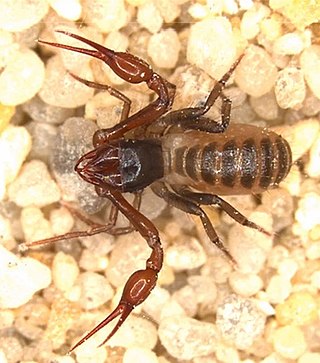
Periplaneta is a genus of cockroaches containing some of the well-known pest species with cosmopolitan distributions, such as:
Cryptocheiridium is a genus of pseudoscorpions in the Cheiridiidae family. It was described in 1931 by American arachnologist Joseph Conrad Chamberlin.
Nesidiochernes is a genus of pseudoscorpions in the Chernetidae family. It was described in 1957 by Austrian arachnologist Max Beier.
Synsphyronus is a genus of pseudoscorpions in the Garypidae family. It was described in 1930 by American arachnologist Joseph Conrad Chamberlin. Its distribution is mainly in Australia, but also extends to New Zealand and New Caledonia.
Austrochthonius is a genus of pseudoscorpions in the family Chthoniidae. It was described in 1929 by American arachnologist Joseph Conrad Chamberlin.
Sathrochthonius is a genus of pseudoscorpions in the family Chthoniidae. It was described in 1962 by American arachnologist Joseph Conrad Chamberlin.

Pseudotyrannochthonius is a genus of pseudoscorpions in the family Pseudotyrannochthoniidae. It was described in 1930 by Austrian arachnologist Max Beier.
Nesidiochernes is a monotypic genus of pseudoscorpions in the Chernetidae family. It is native to Oceania, and was described in 1932 by Austrian arachnologist Max Beier.
Paraustrochernes victorianus is a species of pseudoscorpion in the Chernetidae family. It is endemic to Australia. It was described in 1966 by Austrian arachnologist Max Beier. The specific epithet victorianus refers to the type locality.
Sundochernes is a genus of pseudoscorpions in the Chernetidae family. It was described in 1932 by Austrian arachnologist Max Beier.
Calymmachernes is a monotypic genus of pseudoscorpions in the Chernetidae family. It is endemic to Australia. It was described in 1954 by Austrian arachnologist Max Beier.

Conicochernes is a genus of pseudoscorpions in the Chernetidae family. It is endemic to Australia. It was described in 1948 by Austrian arachnologist Max Beier.
Megachernes is a genus of pseudoscorpions in the Chernetidae family. It was described in 1932 by Austrian arachnologist Max Beier.
Australochelifer is a monotypic genus of pseudoscorpions in the Cheliferidae family. It was described in 1975 by Austrian arachnologist Max Beier.
Protochelifer is a genus of pseudoscorpions in the Cheliferidae family. It was described in 1948 by Austrian zoologist Max Beier.
Protogarypinus is a genus of pseudoscorpions in the Garypinidae family. It is endemic to Australia. It was described in 1954 by Austrian arachnologist Max Beier.
Solinus is a genus of pseudoscorpions in the Garypinidae family. It was described in 1930 by American arachnologist Joseph Conrad Chamberlin.
Austrohorus is a monotypic genus of pseudoscorpions in the Olpiidae family. It is endemic to Australia. It was described in 1966 by Austrian arachnologist Max Beier.
Beierolpium is a genus of pseudoscorpions in the Olpiidae family. It was described in 1976 by French arachnologist Jacqueline Heurtault.

Olpium is a genus of pseudoscorpions in the Olpiidae family. It was described in 1873 by German arachnologist Ludwig Carl Christian Koch.



